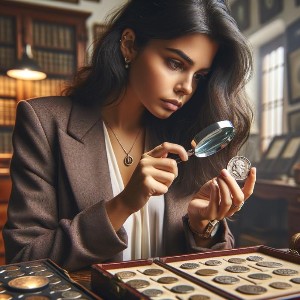The journey into the world of rare coins is one marked by an appreciation for history and a sense for investment opportunities. This narrative explores the interplay between scarcity, historical significance, and the art of numismatics, setting the stage for a comprehensive look at what makes these coins valuable.

Understanding Rare Coins
Rare coins are valued for their scarcity and historical significance. Minting years, production errors, and ties to important events all contribute to a coin's rarity and value.
Annual production volume significantly impacts rarity. Coins minted in limited quantities, often due to economic changes, are harder to find. The 1916-D Mercury Dime, with its small output, is prized by collectors.
Minting errors, like double stamping or incorrect metal usage, make coins unique and desirable. The 1955/55 Doubled Die Lincoln Cent is a famous example.
Coins from pivotal historical moments, such as the end of an era or significant societal shifts, carry added weight. They are time capsules recording the course of human history.
Assessing rare coins requires keen observation to spot differences or errors and an understanding of their histories and production.
Investing in rare coins combines owning a piece of history with recognizing potential value. It involves spotting the standouts among many options, considering rarity, errors, and historical significance.
Key Rare Coins for Investment
Let's examine a few rare coins that shine in the world of numismatic investments, offering a blend of rarity, historical interest, and potential value.
- The 1909-S V.D.B. Lincoln Cent is notable for its scarce initial mintage and the story of its engraver's initials being removed. This penny is a key part of American coinage history.
- The 1914-D Lincoln Cent, while less storied in production anomalies, is valued for its sheer scarcity. Minted in a year when the world was on the brink of global conflict, its limited numbers make it a collector's prize.
- The 1937-D 3-Legged Buffalo Nickel is a coin that turns an error into a selling point. The accidental removal of one of the buffalos' legs result in a rare and sought-after piece.
Each of these coins represents a facet of what makes a coin collectable and a potential investment. Their rarity, historical context, and demonstrated appreciation potential showcase why they stand out.
Investing in rare coins combines an interest in history with financial considerations. With knowledge and an eye for detail, an investor can find opportunities that are intellectually and financially rewarding.

Evaluating and Acquiring Rare Coins
Evaluating and acquiring rare coins requires an understanding of grading standards and certification, which uphold the integrity of coin collecting and investing.
Grading assesses a coin's condition on a scale from perfect Mint State (MS) or Proof (PF) to those showing wear from circulation. The grade summarizes a coin's condition, rarity, and appeal.
Certification provides a coin's seal of authenticity and quality. Respected third-party grading services like PCGS and NGC assess and encapsulate coins in tamper-evident holders, ensuring condition and authenticity. This adds credibility and confidence for buyers.
Provenance, or ownership history, can add to a coin's allure and value. Coins from notable collections or with interesting histories may command a premium.
Acquiring rare coins requires vigilance. Reputable dealers bring expertise and help guard against counterfeits. Look for dealers affiliated with respected organizations like the PNG or with strong reputations.
Numismatic shows and auctions offer a chance to view many coins, learn from the community, and build relationships. They provide a way to gauge the market and potentially find hidden gems.
Caution is important, as counterfeit coins do exist. Knowledge, trusted relationships, and relying on respected certification can help avoid pitfalls.
Investing in rare coins combines financial considerations with an appreciation for history. A diligent approach that prioritizes authenticity and provenance sets the stage for a rewarding numismatic journey.

Rare Coin Market Trends
The rare coin market is dynamic and resilient, driven by passionate collectors and the enduring appeal of historical artifacts.
Recent years have seen varied price movements. Some rare coins, especially those with unique histories or low mintages, have appreciated significantly. This reflects growing demand from collectors and investors.
Interest has surged for coins with compelling stories or rare errors. Investors are drawn not just to potential returns but to the historical significance these coins hold.
Experts are optimistic about the market's future. Predictions consider factors like the economy, interest in tangible assets, and new numismatic discoveries. Digital technology and online platforms are also making rare coin trading more accessible.
Rarity remains a key driver of value, especially for coins with historical importance that are in top condition. Market movements are influenced by trends in collecting for enjoyment, education, and investment.
Blockchain technology is being used more for provenance tracking and authentication, boosting buyer confidence and transactional transparency.
The rare coin market offers both opportunity and fascination. Navigating it well involves financial understanding and an appreciation for the artistry and history of each coin.
The appeal of rare coins goes beyond financial gain; they connect us with key moments in history. Successful numismatic investment blends a passion for this history with a recognition of future value potential. By balancing these interests, collectors and investors can pursue both knowledge and financial rewards in this fascinating field.
- Travers FJ. The Collectors Guide to Rare Coins. New York, NY: Whitman Publishing; 2021.
- Jenkins MR. Coin Grading and Certification: Preserving Numismatic Integrity. Coin World. 2020;61(3):34-37.
- Henderson LB. Market Trends in Rare Coin Investing. Journal of Numismatic Investment. 2022;15(2):57-63.

